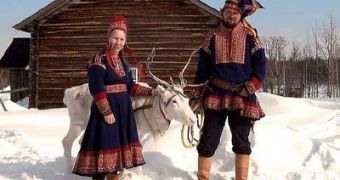1. In the extreme north of the Fennoscandian peninsula, the Saami (Lapps), a shepherd population that still follows an ancestral way of life, live, despite the tough clime of their homeland. Most of the Lapps actually live over the Polar Circle, but these people developed a culture adapted to the subpolar climate, based on the reindeer husbandry; other activities are complementary, like fishing in Norway or hunting (of beaver and fur animals) for those of the Russian Kola peninsula. Lapp lifestyle, in the case of the traditional groups, is dictated by the seasonal migrations of the reindeer herds, when Lapp families have to move their goods. The reindeer migration (involving both wild and domestic animals) is made to the northern tundra in the spring, both for finding food and escaping blood-sucking mites, while the winter is passed into the northern forests, where the clime is milder and the animals can feed on bushes and soft branches.
Because of the nomad life, Lapps do not have fix houses, but easy to dismount tents. The simplest tent is circular, with a central post on which several posts lean, disposed in a circle. Over this skeleton, a reindeer skin cover is disposed. Other type, more complicated, is made of four flexible branches thrust on the ground on both ends and over whose cupola the other posts were located, over which the cover was put.
In the center of the tent the firebed was placed, being made of various stones, and the smoke got out through a hole on the top of the tent. Today, these tents are used only during the summer, when following the reindeer herds; during the winter, the Lapps live in comfortable wooden huts, with the roofs covered by pits, very similar to the trunk houses made by the Russian farmers (izba).
2. Lapps came from Siberia about 2 millennia ago. They were Mongoloid people at origin, and many still keep the Mongoloid type, even if the mix with Northern Europeans has made most of them to look blue-eyed blond. Still, the Lapps are much shorter than their Indo-European neighbors and even than their relatives, the Finns, which mixed much heavily with the Europeans. They belong to the same Mongoloid branch that gave rise to the Finns, Estonians and Hungarians and all these people today speak related languages (even if they look European as race because of the mix with Germanics, Slavs or Romanians), close to those spoken by some western Siberian tribes. Do not confound the Lapps with the prehistoric European people of the reindeer culture! They inhabited Europe over 10,000 years earlier and they were not Mongoloid.
3. Children were put in small cradles made of emptied fir trunks and covered by skins which protected against rain or snow. The interior of the cradle was covered with the finest skins of young reindeer. The children wore a garment made of mountain hare skin, white and very fine and secured with belts. The cradles were located on the back of the reindeer.
4. Reindeer meat is quite tough, that's why young animals are usually sacrificed, and the meat was conserved smoked. The reindeer milk, even if the female does not deliver more than one litter, was used for making cheese and butter. Only women milked the reindeer. The reindeer skin was used for clothing, mantles, belts, food bags and tent covers. The tendons were used for cords and sewing clothes. The antlers and bones were employed for making knives, spoons, vessels, awls and others. Antlers and bones were also used for making carvings. Today, the traditional skin clothes are adorned with fabric frills and belts. These are bright and multicolor, and Lapp women often add copper threads to them. The reindeer is rather a semidomestic animal; it is often attracted just by the salt offered by humans.
The Lapp hat has various points; some hats end in a large pompom. The footwear was represented by moccasins made of reindeer skin with fur inside. They were sheathed with dry grass for keeping warmth.
Initially, the Lapps did not keep reindeer, but hunted them. By the 10th century BC, this habit seems to have been transmitted from some Siberian tribes. Each family has between 100 and thousands of reindeer and their care required the effort of the whole family. Because the herds graze together, each owner marks the ears of his reindeer. Each herd has a male leader, and that reindeer wears a cowbell, so that the owner can easily locate him. On certain occasions, especially during the winter, to protect the animals against the snow storms or wolves, reindeer are gathered in enclosures.
Reindeer is also used for transport and traction. An adult male can easily bear 75 kg (180 pounds), as much as a horse could bear in the freezing tundra conditions. Moreover, the hooves of the reindeer are much securer, on the rocky or swampy terrains, than that of the horse. The reindeer can make 80 km (50 mi) per day, much more than the powerful Russian horses, on the same territory.
The reindeer driven sleds can be used both on the frozen tundra and on mossy terrain. The Lapp sled is large, made of wood and skin. The pieces are secured using belts and tendons of reindeer. During the seasonal displacements, the Lapp family puts all its goods in the sleds. The reindeer are yoked to the sleds trough leather harnesses, which are fixed over the chest of the animal and passed between its rear limbs.

 14 DAY TRIAL //
14 DAY TRIAL //